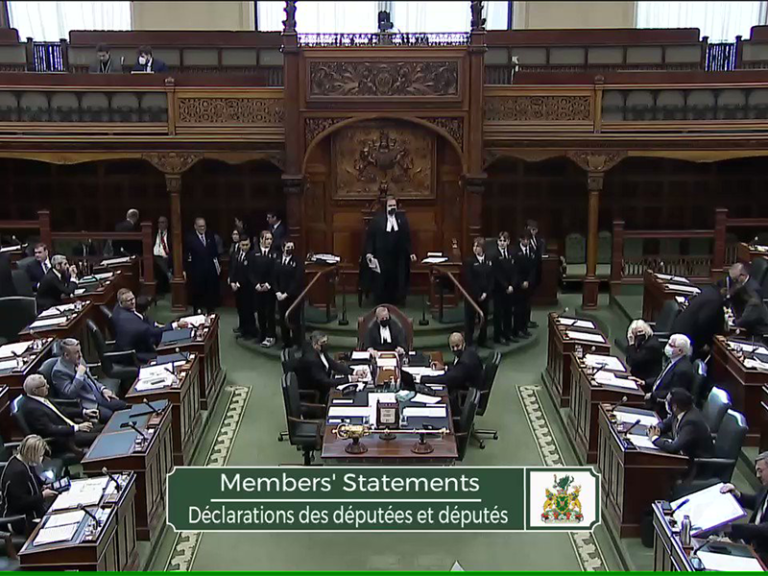First published: July 22, 2004
by Keith Oliver
This is the fifth in a series of articles about the process of planning for the growth and development of human settlements in general, and the 500 hectare northeast corner of Cobourg, known as Area C, in particular. 30 years from now, when this two square mile area is fully developed, Cobourg will be twice its present size.
There is nothing arbitrary in the makeup of a successful human settlement. Everything, from its social and economic life, to the details of its physical construction and its garbage pickup schedule, is the way it is in response to a need. Where things go wrong is when the price of goods and services do not reflect their true costs and special interests are out of balance with each other. This is the case with our long and faithful romance with the automobile (love is blind we are told), and the fact that we continue to allow private interests, as opposed to public interests, to design the residential areas that have been built since the Second World War. As a result our personal transportation costs, both in money and time spent, are the highest in history and we no longer live in real neighbourhoods.
Automobile-dependency has directly affected land-use planning.
Pebble Beach, Westwood, Chipping Park, Maplewood, Coverdale and Fitzhugh Shores have no neighbourhood centres and are totally auto-dependant. In each you must drive if you run out of milk or laundry detergent, or your daughter has a soccer game, or you work outside your home. If you live as close to the mall as the homes on the north side of Carlisle Street and you forgot to buy bread and your car won’t start, a fence along the south side of the mall turns what could have been a 10 minute round-trip by foot into a 40 minute walk. The mall is totally oriented toward automobile traffic on Elgin Street and pays no respect to the large residential area to its south. Even if the fence were removed the mall is not designed to admit pedestrians from the south side and there is always the chance of getting run over by a delivery truck
Relying on the automobile so completely and the conviction that owing one is a birth-right, has caused us to deny its long-term consequences. Miles driven per household and the number of vehicles on the road increase every year, as does congestion. More driving is required when major retail is relocated to high volume highways and the land-use “neighbourhood commercial” is not found inside residential areas any more, but outside, at the intersection of 4-lane arterial roads. Because poor land-use planning has made efficient and affordable public transit impossible, the local school board is in the costly business of bussing. Jobs continue to move to the suburbs to the point where the greatest increase in commuter traffic is not from city to suburb, but from suburb to suburb. The low residential and job densities in the sprawling suburbs makes efficient cost-effective transit routes impossible, and many low-income wage earners cannot find better paying jobs-with-a-future because they cannot afford a car to get to them.
The true cost of the private automobile.
In the case of the automobile, if all government subsidies to its production and infrastructure were removed and if the true costs of delivering fossil fuels from under the ground to the gas tank were included in the price at the pump, automobiles would cost thousands of dollars more and gasoline would sell for two to five dollars a litre. Even with these subsidies the CAA calculates that the direct personal cost of owning a car is 8,000 dollars a year of after-tax income. Reducing the family fleet by one car would save at least this much. Fewer cars would also mean less solid or liquid particulate matter of 10 micros or less in the air we breath and against which our respiratory system has no natural defence. Respiratory illness is on the rise, especially in children whose smaller body mass relative to lung capacity makes them more vulnerable.
Solving automobile-dependency has many benefits.
Developing a land-use base that makes public transit a viable alternative to the private automobile is the only workable solution to the planning and transportation mess we are in. Subsidizing public transit alone will never work; it is simply too expensive. What is encouraging is that transit-supportive land-use planning, the only realistic and affordable solution, can easily be put into effect, is cheap, results in a better and more efficient organization of land-use throughout the town and brings with it many other equally important benefits.
*To put it another way, planning land-use in support of efficient and affordable public transit is the organizing principle that is needed to counter dysfunctional planning and land-use based on the unlimited mobility of the private automobile. Before the Second World War, in cities that relied on streetcars as the primary means of moving people, the organization of land-use in urban areas made much more sense than it does today. There was less sprawl and land-use was organized around a fixed system of streetcar tracks. It was the streetcar that provided the organizing principle for urban growth. Now that organizing principle is the economics of an efficient and affordable transit system.
*To provide enough daily riders to make public transit attractive, efficient and affordable, two land-use goals must be achieved. Residential densities must average a minimum of 36 dwellings per hectare (dph) within a 400 metre walking distance of a bus stop, and neighbourhood centres and non-residential land-use must be organized into coherent transit-destinations along transit routes that make sense in the context of the town as a whole. To do this successfully the design of different development projects must be based on transit-supportive land-use guidelines, be carefully coordinated and the plan for the town as a whole must be clear to everyone and it must be followed.
The first step is to build better neighbourhoods.
*While debating and defining solutions to the effects of automobile-dependency on the quality and cost of our present life-style, and knowing that the problems associated with absolute dependency will only get worse before they get better, and admitting that we are more attracted to short-term benefits as opposed to long-term solutions, the desired changes must be able to offer some immediate benefit … and they can.
*In the spirit of the expression “think globally, act locally”, the first practical step is to begin to build better neighbourhoods. A wider choice of housing must be available to all income-groups and housing types skilfully mixed. To encourage people to walk there must be a neighbourhood centre that satisfies daily and weekly needs; street patterns must be reorganized into a coherent modified grid with shorter residential blocks that offer more choice to pedestrians as to how they can reach a given destination; pedestrian-only pathways must be created where necessary to shorten distances to transit stops, offer safer routes to children going to school and playgrounds, and to connect everyone to public open space.
The neighbourhood centre is different from the centre-of-the-community, described in the fourth article. It is more private and intimate as are neighbourhoods where outsiders are watched with a healthy degree of suspicion. On the other hand the single centre-of-the-community serves the public and civic needs of the whole town. Strangers are welcome as individuals from all backgrounds meet, reconcile their differences and create shared community values.
Within a 400 metre walk of homes in an area with an average residential density of 36 dph, (the same minimum residential needed to support public transit) a neighbourhood centre can support: a small neighbourhood square (see figures 1 and 2) with an elementary school and church on one side and recreational facilities with a field behind the school; a convenience store, a bakery, a coffee shop, a delicatessen, a store-front branch library and public meeting space (seniors day programs, book-club at night), a butcher shop, a small drugstore, a beauty salon and barber shop, a green grocer and flower shop, a specialty gift shop that sells books and cards, a day-care, a children’s toy and clothing store, a transit stop, and several small speciality stores that would attract people from outside the neighbourhood.
Better neighbourhoods help achieve a more compact urban form.
The result of transit-supportive land-use and better neighbourhoods is the more efficient use of land and the development of a more compact urban form. Achieving this urban form also results in easier access to special areas in the town as a whole; a better sense and experience of community; a wider choice of housing types; balanced mixed use areas; significant savings in the cost of delivering municipal services; more accessible and better quality public space; better protection for sensitive environmental systems; more efficient energy use; and ultimately the conservation and protection of valuable agricultural land.
Is this all too god to be true?
Not only is this kind of development possible, it has already been done! In England it began with benevolent Victorian industrialists building small settlements for their workers and continued with the Garden City and New Town Movement that built the New Towns of Letchworth and Welwyn in the early 1900s and the 16 New Towns that followed, ending with the City of Hook southwest of London that was planned to be started in the late 1960s and grow to 100,000 people in 50 years. The Swedes have done it, the French have done it and the Danes have done it. Lessons have been learned, examples abound, the need exists; all we lack is the political will.
Note: Part 5


